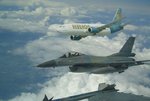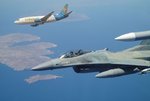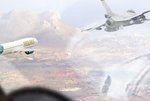FLYBOYJ
"THE GREAT GAZOO"
Got this today from a friend....
Greetings,
Attached are photos of the Cypriot Helios 737-300. Looking at the photos, it appears that the aiplane is flying with 2 units of flaps. I wonder what that's all about.
-----------------------------------------
Cockpit Confusion Found in Crash of Cypriot Plane
By DON PHILLIPS, International Herald Tribune
Published: September 7, 2005
PARIS, Sept. 6 - The crew members of a Cypriot airliner that crashed Aug. 14 near Athens became confused by a series of alarms as the plane climbed, failing to recognize that the cabin was not pressurizing until they grew mentally disoriented because of lack of oxygen and lost consciousness, according to several people connected with the investigation into the crash.
Complicating the cockpit confusion, neither the German pilot nor the young, inexperienced Cypriot co-pilot could speak the same language fluently, and each had difficulty understanding the other's English, the worldwide language of air traffic control. So much for English being the language of aviation.
A total of 121 people were killed in the crash after the plane climbed and flew on autopilot, circling near Athens until one engine stopped running because of a lack of fuel. The sudden imbalance of power, with only one engine operating, caused the autopilot to disengage and the plane to begin to fall. This is a euphemism for a
lawndart into the mountains of Greece. So far, the Greek authorities have hinted at oxygen problems but have not announced the full findings of investigaton. The people interviewed for this article agreed to speak only on the condition that they not be identified because none are official spokesmen for the investigation and because of political sensitivities arising from a Cypriot plane's crashing in Greece.
Investigators pieced together the story of the crash from many sources. In the wreckage, they found the first solid clues: the pressurization valve and an air outflow valve set incorrectly. Air traffic control tapes provided information on the confusion in the cockpit. The plane had a sophisticated new flight data recorder that
provided a wealth of information. There were maintenance records from the night before, and investigators interviewed the mechanics who worked on the plane.
Among other things, the investigators determined that the pilot was not in his seat because he was up trying to solve a problem that turned out to be one of the lesser threats facing the plane. The plane that crashed, a Boeing 737-300, underwent maintenance the night before. The maintenance crew apparently left a
pressurization controller rotary knob out of place, according to the officials connected to the investigation, and the crew did not catch the mistake during preflight checks the next day. This meant that the plane could not pressurize properly. Pushing the button in and selecting AUTO will solve this problem, usually verified to be there on the Before Starting Engines checklist.
At 10,000 feet, an alarm went off to warn the crew that the plane would not pressurize. Crew members mistakenly thought that the alarm horn was a warning to tell them that their controls were not set properly for takeoff, the officials said. This siren and RED warning lights are rather hard to ignore, leveling off the plane until the problem is dealt with is considered the first response.
The same horn is used for both conditions, although it will sound for takeoff configuration only while the plane is still on the ground. The BIG RED lights usually will differentiate the problem. The climb continued on autopilot. At 14,000 feet, oxygen masks deployed as designed, and a master caution light illuminated in the
cockpit. Another alarm sounded at about the same time on an unrelated matter, warning that there was insufficient cooling air in the compartment housing avionics equipment. This is caused by insufficient airflow and, oh yes, the immediate action item is to don Oxygen Masks and check 100% oxygen is flowing, declare and emergency and descend.
The radio tapes showed that this created tremendous confusion in the cockpit. Normally an aircraft cabin is held at 8,000 feet pressure, so the crew at over 14,000 feet would already be experiencing some disorientation because of a lack of oxygen. During this time, the captain and co-pilot discovered that they had no common language and that their English was not good enough for the complicated technical conversation required to fix the problem. Unbelievable!
The crew members called the maintenance base in Cyprus and were told that the circuit breaker to turn off the loud new alarm was in a cabinet behind the captain. The captain got up from his seat to look for the circuit breaker, apparently ignoring the confused co-pilot. As the plane continued to climb on autopilot, the air grew so thin that the crew became seriously impaired. The captain lost consciousness first on the floor of the cockpit, followed by the co-pilot, who remained in his seat, according to the officials. The autopilot did as it was programmed to do, flying the plane at 34,000 feet to Athens and entering a holding pattern. It remained
in a long circling pattern, shadowed by Greek military jets, until fuel ran low and one engine quit.
Boeing, the maker of the plane, issued a notice shortly after the crash to airlines that it would revise flight crew training manuals to emphasize to crews that they must understand how the various warning systems work and what to do about them. This was caused by very bad training and a fundamental lack of how systems work on a commercial airliner. The notice emphasizes that the takeoff configuration warning horn will not sound under any circumstances after the plane has left the
ground. The same horn will then be used only for a cabin altitude warning. The company notice said there had been other instances of confusion over the horn by pilots. "Confusion between the cabin altitude warning horn and the takeoff configuration warning horn can be resolved if the crew remembers that the takeoff configuration warning horn is only armed when the airplane is on the ground, " the notice said. "If this horn is activated in flight, it indicates that the cabin altitude has reached 10,000 feet."
Greetings,
Attached are photos of the Cypriot Helios 737-300. Looking at the photos, it appears that the aiplane is flying with 2 units of flaps. I wonder what that's all about.
-----------------------------------------
Cockpit Confusion Found in Crash of Cypriot Plane
By DON PHILLIPS, International Herald Tribune
Published: September 7, 2005
PARIS, Sept. 6 - The crew members of a Cypriot airliner that crashed Aug. 14 near Athens became confused by a series of alarms as the plane climbed, failing to recognize that the cabin was not pressurizing until they grew mentally disoriented because of lack of oxygen and lost consciousness, according to several people connected with the investigation into the crash.
Complicating the cockpit confusion, neither the German pilot nor the young, inexperienced Cypriot co-pilot could speak the same language fluently, and each had difficulty understanding the other's English, the worldwide language of air traffic control. So much for English being the language of aviation.
A total of 121 people were killed in the crash after the plane climbed and flew on autopilot, circling near Athens until one engine stopped running because of a lack of fuel. The sudden imbalance of power, with only one engine operating, caused the autopilot to disengage and the plane to begin to fall. This is a euphemism for a
lawndart into the mountains of Greece. So far, the Greek authorities have hinted at oxygen problems but have not announced the full findings of investigaton. The people interviewed for this article agreed to speak only on the condition that they not be identified because none are official spokesmen for the investigation and because of political sensitivities arising from a Cypriot plane's crashing in Greece.
Investigators pieced together the story of the crash from many sources. In the wreckage, they found the first solid clues: the pressurization valve and an air outflow valve set incorrectly. Air traffic control tapes provided information on the confusion in the cockpit. The plane had a sophisticated new flight data recorder that
provided a wealth of information. There were maintenance records from the night before, and investigators interviewed the mechanics who worked on the plane.
Among other things, the investigators determined that the pilot was not in his seat because he was up trying to solve a problem that turned out to be one of the lesser threats facing the plane. The plane that crashed, a Boeing 737-300, underwent maintenance the night before. The maintenance crew apparently left a
pressurization controller rotary knob out of place, according to the officials connected to the investigation, and the crew did not catch the mistake during preflight checks the next day. This meant that the plane could not pressurize properly. Pushing the button in and selecting AUTO will solve this problem, usually verified to be there on the Before Starting Engines checklist.
At 10,000 feet, an alarm went off to warn the crew that the plane would not pressurize. Crew members mistakenly thought that the alarm horn was a warning to tell them that their controls were not set properly for takeoff, the officials said. This siren and RED warning lights are rather hard to ignore, leveling off the plane until the problem is dealt with is considered the first response.
The same horn is used for both conditions, although it will sound for takeoff configuration only while the plane is still on the ground. The BIG RED lights usually will differentiate the problem. The climb continued on autopilot. At 14,000 feet, oxygen masks deployed as designed, and a master caution light illuminated in the
cockpit. Another alarm sounded at about the same time on an unrelated matter, warning that there was insufficient cooling air in the compartment housing avionics equipment. This is caused by insufficient airflow and, oh yes, the immediate action item is to don Oxygen Masks and check 100% oxygen is flowing, declare and emergency and descend.
The radio tapes showed that this created tremendous confusion in the cockpit. Normally an aircraft cabin is held at 8,000 feet pressure, so the crew at over 14,000 feet would already be experiencing some disorientation because of a lack of oxygen. During this time, the captain and co-pilot discovered that they had no common language and that their English was not good enough for the complicated technical conversation required to fix the problem. Unbelievable!
The crew members called the maintenance base in Cyprus and were told that the circuit breaker to turn off the loud new alarm was in a cabinet behind the captain. The captain got up from his seat to look for the circuit breaker, apparently ignoring the confused co-pilot. As the plane continued to climb on autopilot, the air grew so thin that the crew became seriously impaired. The captain lost consciousness first on the floor of the cockpit, followed by the co-pilot, who remained in his seat, according to the officials. The autopilot did as it was programmed to do, flying the plane at 34,000 feet to Athens and entering a holding pattern. It remained
in a long circling pattern, shadowed by Greek military jets, until fuel ran low and one engine quit.
Boeing, the maker of the plane, issued a notice shortly after the crash to airlines that it would revise flight crew training manuals to emphasize to crews that they must understand how the various warning systems work and what to do about them. This was caused by very bad training and a fundamental lack of how systems work on a commercial airliner. The notice emphasizes that the takeoff configuration warning horn will not sound under any circumstances after the plane has left the
ground. The same horn will then be used only for a cabin altitude warning. The company notice said there had been other instances of confusion over the horn by pilots. "Confusion between the cabin altitude warning horn and the takeoff configuration warning horn can be resolved if the crew remembers that the takeoff configuration warning horn is only armed when the airplane is on the ground, " the notice said. "If this horn is activated in flight, it indicates that the cabin altitude has reached 10,000 feet."





